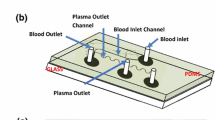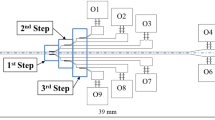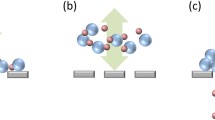Abstract
This article presents a new microfluidic-based filter for the separation of microbeads or blood cells with a high filtration rate. The device was composed of a circular micropump for automatic liquid transport, and a normally closed valve located at the filter zone for separation of beads or cells. The filtration mechanism was based on the tunable deformation of polydimethylsiloxane (PDMS) membranes that defined the gap between a floating block structure and the substrate which determined the maximum diameter of the beads/cells that can pass through the filter. Another unique feature of this filter is an unclogging mechanism using a suction force, resulting in a back flow to remove any trapped beads/cells in the filter zone when the PDMS membrane was restored to its initial state. The separation performance of the proposed device was first experimentally evaluated by using microbeads. The results showed that this device was capable of providing size-tunable filtration with a high recovery efficiency (95.25–96.21%) for microbeads with sizes smaller than the defined gap in the filter zone. Furthermore, the proposed device was also capable of performing separation of blood cells and blood plasma from human whole blood. Experimental results showed that an optimum filtration rate of 21.40 and 3.00 μl/min correspond to high recovery efficiencies of 86.69 and 80.66%, respectively, for red blood cells (RBCs) and blood plasma. The separation method developed in this work could be used for various point-of-care diagnostic applications involving separation of plasma and blood cells.








Similar content being viewed by others
Abbreviations
- AARBCs:
-
Adult anucleate red blood cells.
- BSA:
-
Bovine serum albumin
- CCD:
-
Charge-coupled device
- DEP:
-
Dielectrophoretic
- EMV:
-
Electromagnetic valve
- PDMS:
-
Polydimethylsiloxane
- RBCs:
-
Red blood cells
- WBCs:
-
White blood cells
- μ-TAS:
-
Micro-total-analysis-system
- e+FNRBCs:
-
Epsilon-globin positive fetal nucleated red blood cells
References
Arakeri JH (2000) Bernoulli’s equation. Resonance 5:54–71
Blattert C, Jurischka R, Tahhan I, Schoth A, Reinecke H (2006) Improved plasma yield by a new design of microchannel bend structures. MicroTAS 2006, Tokyo, pp 146–148
Chalmers JJ, Moore LR (2007) Analytical magnetic techniques in biology. Magnetic cell separation. Lab Tech Biochem Mol Biol 32:225–247
Chen X, Cui DF, Liu CC, Li H (2008) Microfluidic chip for blood cell separation and collection based on crossflow filtration. Sens Actuators B 130:216–221
Fukuda S, Schmid-Schonbein GW (2002) Centrifugation attenuates the fluid shear response of circulating leukocytes. Leukoc Biol 72:133–139
Haik Y, Pai V, Chen CJ (1999) Development of magnetic device for cell separation. J Magn Magn Mater 194:254–261
Hallden G, Nopp A, Ihre E, Peterson C, Lundahl J (1999) Conditions in blood sampling procedures that extend the ex vivo stability of eosinophil activity markers in peripheral blood from allergic patients and healthy controls. Ann Allergy Asthma Immunol 83:413–421
Hester JP, Kellogg RM, Mulzet AP, Kruger VR, McCredie KB, Freireich EJ (1979) Principles of blood separation and component extraction in a disposable continuous-flow single-stage channel. Blood 54:254–268
Huang SB, Wu MH, Lee GB (2009) A tunable micro filter modulated by pneumatic pressure for cell separation. Sens Actuators B 142:389–399
Huang CJ, Lin HI, Shiesh SC, Lee GB (2010a) Integrated microfluidic system for rapid screening of CRP aptamers utilizing systematic evolution of ligands by exponential enrichment (SELEX). Biosens Bioelectron 25:1761–1766
Huang CT, Li PN, Pai CY, Leu TS, Jen CP (2010b) Design and simulation of a microfluidic blood-plasma separation chip using microchannel structures. Sep Sci Technol 45:42–49
Ji HM, Samper V, Chen Y, Heng CK, Lim TM, Yobas L (2008) Silicon-based microfilters for whole blood cell separation. Biomed Microdevices 10:251–257
Jung JY, Kwak HY (2007) Separation of microparticles and biological cells inside an evaporating droplet using dielectrophoresis. Anal Chem 79:5087–5092
Jung Y, Choi Y, Han KH, Frazier AB (2010) Six-stage cascade paramagnetic mode magnetophoretic separation system for human blood samples. Biomed Microdevices 12:637–645
Kerhoas MK, Dhariwal R, Desmulliez MPY, Jouvet L (2010) Hydrodynamic blood plasma separation in microfluidic channels. Microfluid Nanofluid 8:105–114
Kim YC, Kim SH, Heo PW, Park JK (2009) A power-free blood plasma extraction device based on planar crossflow filter microstructure. Transducers, Denver, pp 920–923
Kobayashi T, Funamoto T, Hosaka M, Konishi S (2010) Centrifugal separation device based on two-Layer laminar flow in microchannels for high-throughput and continuous blood cell/plasma separation. Jpn J Appl Phys 49:077001
Lee D, Sukumar P, Mahyuddin A, Choolani M, Xu G (2010) Separation of model mixtures of epsilon-globin positive fetal nucleated red blood cells and anucleate erythrocytes using a microfluidic device. J Chromatogr A 1217:1862–1866
Lin L, Guthrie JT (2000) Preparation and characterisation of novel, blood-plasma-separation membranes for use in biosensors. J Membr Sci 173:73–85
Lundahl J, Hallden G, Hallgren M, Skold CM, Hed J (1995) Altered expression of Cd11b/Cd18 and Cd62l on human monocytes after cell preparation procedures. J Immunol Methods 180:93–100
Markx GH, Huang Y, Zhou XF, Pethig R (1994) Dielectrophoretic characterization and separation of micro-organisms. Microbiology 140:585–591
Nakashima Y, Hata S, Yasuda T (2010) Blood plasma separation and extraction from a minute amount of blood using dielectrophoretic and capillary forces. Sens Actuators B 145:561–569
Pommer MS, Zhang YT, Keerthi N, Chen D, Thomson JA, Meinhart CD, Soh HT (2008) Dielectrophoretic separation of platelets from diluted whole blood in microfluidic channels. Electrophoresis 29:1213–1218
Shim JS, Browne AW, Ahn CH (2010) An on-chip whole blood/plasma separator with bead-packed microchannel on COC polymer. Biomed Microdevices 12:949–957
Solliera E, Rostainga H, Pouteaua P, Fouilleta Y, Achard JL (2009) Passive microfluidic devices for plasma extraction from whole human blood. Sens Actuators B 141:617–624
Steigert J, Brenner T, Grumann M, Riegger L, Lutz S, Zengerle R, Ducrée J (2007) Integrated siphon-based metering and sediment of whole blood on a hydrophilic lab-on-a-disk. Biomed Microdevices 9:675–679
Tachi T, Kaji N, Tokeshi M, Baba Y (2009) Simultaneous separation, metering, and dilution of plasma from human whole blood in a microfluidic system. Anal Chem 81:3194–3198
van Mullem CJ, Gabriel KJ, Fujita H (1991) Large deflection performance of surface micromachined corrugated diaphragms. Transducers, San Fransisco, pp 1014–1017
Wu HW, Lin XZ, Hwang SM, Lee GB (2009) A microfluidic device for separation of amniotic fluid mesenchymal stem cells utilizing louver-array structures. Biomed Microdevices 11:1297–1307
Yang S, U¨ndar A, Zahn JD (2006) A microfluidic device for continuous, real time blood plasma separation. Lab Chip 6:871–880
Yang YN, Hsiung SK, Lee GB (2009) A pneumatic micropump incorporated with a normally closed valve capable of generating a high pumping rate and a high back pressure. Microfluid Nanofluid 6:823–833
Yang SY, Cheng FY, Yeh CS, Lee GB (2010) Size-controlled synthesis of gold nanoparticles using a micro-mixing system. Microfluid Nanofluid 8:303–311
Acknowledgments
The authors gratefully acknowledge the financial support provided to this study by the National Science Council in Taiwan (NSC 99-2627-B-006-004).
Author information
Authors and Affiliations
Corresponding author
Rights and permissions
About this article
Cite this article
Chang, YH., Huang, CJ. & Lee, GB. A tunable microfluidic-based filter modulated by pneumatic pressure for separation of blood cells. Microfluid Nanofluid 12, 85–94 (2012). https://doi.org/10.1007/s10404-011-0851-0
Received:
Accepted:
Published:
Issue Date:
DOI: https://doi.org/10.1007/s10404-011-0851-0




